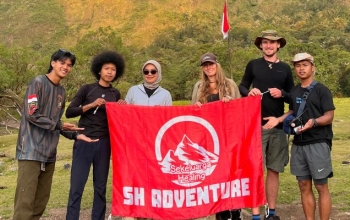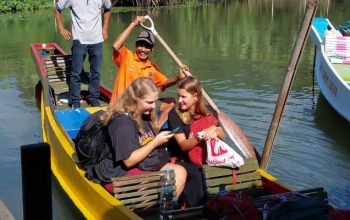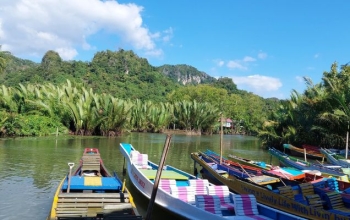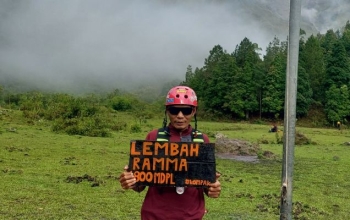- Selamat datang, silahkan pilih destinasi tujuan Anda, Kami dengan senang hati akan memberikan service terbaik.
Located in the heart of South Sulawesi, Indonesia, Rammang-Rammang is one of the most extraordinary karst landscapes in the world. Nestled within the Maros-Pangkep Geopark, this breathtaking natural wonder features towering limestone cliffs, vast green valleys, and a network of rivers and caves that have shaped the area for millions of years. For travelers seeking an authentic blend of adventure and serenity, visiting Rammang-Rammang offers an unforgettable journey through nature’s ancient masterpiece.
This article provides a comprehensive guide to the route leading to Rammang-Rammang, detailing the various transportation options, scenic highlights along the way, and what visitors can expect upon arrival.
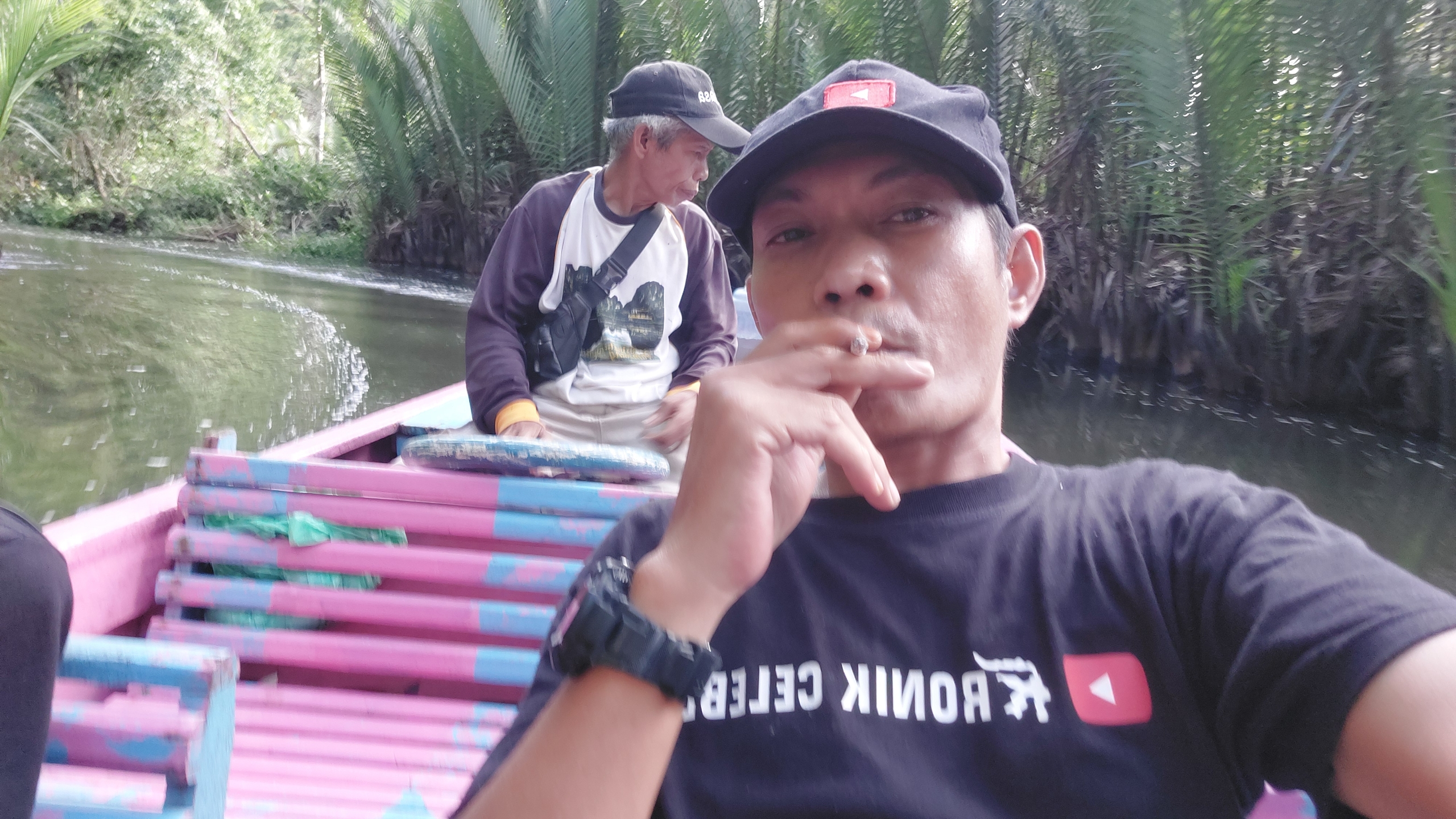
Introduction: The Allure of Rammang-Rammang
Rammang-Rammang, whose name means “a cluster of clouds or mist” in the local Makassarese language, lives up to its poetic description. Each morning, a soft layer of fog often blankets the karst towers, creating an ethereal and mystical panorama. This natural phenomenon, combined with the area’s geological and cultural richness, makes Rammang-Rammang one of Indonesia’s hidden gems and a growing destination for eco-tourism.
The karst formation of Maros is part of one of the largest karst areas in the world, stretching across approximately 45,000 hectares. Scientists estimate that these limestone towers began forming over 200 million years ago, shaped by natural erosion, rain, and underground rivers. The landscape is not only visually stunning but also of significant scientific importance — home to prehistoric caves with ancient rock art, diverse flora and fauna, and unique ecosystems found nowhere else.
Location Overview
Rammang-Rammang lies within the administrative region of Maros Regency, approximately 40 kilometers north of Makassar, the capital city of South Sulawesi. The karst area forms part of the Maros-Pangkep Karst Geopark, recognized by UNESCO for its geological and cultural value. It is accessible via a combination of road and river routes, offering travelers both convenience and adventure.
Main Route to Rammang-Rammang from Makassar
a. Starting Point: Makassar City
Most visitors begin their journey in Makassar, the main gateway to South Sulawesi. Makassar is well-connected domestically and internationally, with Sultan Hasanuddin International Airport (UPG) serving as the primary entry point. The airport is located about 25 kilometers north of downtown Makassar and roughly 20 kilometers south of Maros.
From the city center, travelers can choose between several transportation options to reach Rammang-Rammang, depending on their budget and preferred level of comfort.
b. Route by Private Car or Motorcycle
For flexibility and convenience, traveling by private car or motorcycle is the most recommended way. The trip from Makassar to Rammang-Rammang typically takes 45 to 60 minutes, depending on traffic conditions.
Directions:
- From Makassar city center, head north along Jl. Poros Maros–Makassar, which is part of the Trans-Sulawesi Highway.
- Pass through several districts including Biringkanaya and Mandai before entering Maros Regency.
- Continue straight until you see road signs pointing toward Rammang-Rammang Village or Dusun Rammang-Rammang in Saluang Village (Desa Salenrang).
- Turn left at the small intersection marked with a sign that reads “Wisata Alam Rammang-Rammang.”
- Follow the narrow village road for about 3 kilometers until you reach the Pabbaresseng River Pier, also known as Dermaga Rammang-Rammang.
The pier serves as the main entrance to the karst area. Along the way, travelers are treated to scenic views of rice fields, local houses, and distant limestone hills that gradually grow larger as they approach the destination.
c. Route by Public Transportation
For travelers without access to private vehicles, several public transportation options are available:
- Pete-pete (public minivans): From Makassar Terminal Daya, take a pete-pete heading toward Maros town. The fare is inexpensive, usually around IDR 10,000–15,000 per person. Once in Maros, transfer to another pete-pete or ojek (motorbike taxi) to Salenrang Village.
- Online ride-hailing services: Applications like Gojek and Grab operate in the area and can be used to book rides directly to Rammang-Rammang. The price may vary depending on time and demand but generally ranges between IDR 80,000–120,000 one way.
- Taxi: A more comfortable but pricier option, taxis from Makassar to Rammang-Rammang cost around IDR 200,000–250,000.
Although public transportation may take longer due to stops and transfers, it offers a chance to interact with locals and experience the everyday life of South Sulawesi residents.
The River Journey: From the Pier to the Karst Village
Upon reaching the Dermaga Rammang-Rammang, the adventure continues with a short but mesmerizing boat ride along the Pabbaresseng River. This part of the journey is what makes Rammang-Rammang truly special — visitors must traverse the tranquil river surrounded by towering karst cliffs, lush mangrove forests, and emerald rice paddies.
a. Boat Details
- Duration: Approximately 20–30 minutes.
- Boat Type: Traditional wooden boats locally known as perahu.
- Capacity: Typically accommodates 4–6 passengers.
- Cost: Around IDR 250,000–350,000 per boat (round trip), depending on negotiation and group size.
Most boat operators are local villagers who work in shifts, providing visitors not only with transportation but also with insight into the local community’s way of life. Some even serve as informal guides, explaining the history and legends of the area during the ride.
b. Sights Along the River
As the boat glides through the calm water, travelers will encounter a series of stunning natural features:
- Towering karst cliffs rising dramatically from the riverbanks.
- Mangrove forests teeming with birds, fish, and crabs.
- Small limestone caves visible from the river’s edge.
- Traditional houses on stilts, where villagers live surrounded by rice fields and waterways.
The combination of calm water reflections, tropical greenery, and majestic limestone formations creates a surreal atmosphere that feels almost otherworldly.
Arriving at the Karst Village of Rammang-Rammang
At the end of the boat journey lies Kampung Rammang-Rammang, a quiet settlement nestled among limestone hills. This village serves as the central hub for exploring the natural attractions of the area. The sound of flowing water, the singing of birds, and the gentle breeze all add to the tranquil charm of the place.
a. Local Attractions
- Stone Forest (Hutan Batu)
- A vast area of limestone towers and boulders that resemble a natural labyrinth. Visitors can walk among the rocks, take photos, and admire the impressive geological formations shaped over millions of years.
- Berlian Cave (Gua Berlian)
- Named after the sparkling minerals inside, this cave features glittering rock surfaces that shimmer under flashlight beams. Local guides are available to accompany visitors for a small fee.
- Telaga Bidadari (Angel’s Lake)
- A serene blue-green pond surrounded by limestone cliffs. The locals believe it was once the bathing place of celestial maidens, adding a touch of mythology to the landscape.
- Prehistoric Caves
- The Maros-Pangkep area is home to some of the oldest known cave paintings in the world, dating back over 40,000 years. Some of these caves, like Leang-Leang, can be visited with a short drive from Rammang-Rammang.
Alternative Routes and Access Points
While the river route from Dermaga Rammang-Rammang is the most iconic, there are also alternative land routes that adventurous travelers can take.
- Land Trail Access: A small paved road leads directly to the Rammang-Rammang village area. This route can be accessed by motorcycle or small car, but the road is narrow and not recommended for large vehicles. The drive offers stunning views of the karst cliffs up close and passes through rural farmland and limestone valleys.
- Cycling Route: For eco-tourism enthusiasts, cycling from Maros town to Rammang-Rammang has become increasingly popular. The 12-kilometer ride takes approximately 45 minutes and allows travelers to enjoy the countryside at a relaxed pace.
Facilities and Visitor Information
Although Rammang-Rammang remains a relatively undeveloped destination, basic tourist facilities are available.
- Parking Area: Provided near the pier and in the village area.
- Restrooms and Prayer Rooms: Located at the boat dock and in several small homestays.
- Food and Drinks: Local warungs (small eateries) sell traditional snacks and beverages such as fried bananas (pisang goreng), coffee, and coconut water.
- Accommodation: Several homestays and eco-lodges are available near the karst area, such as Erni Homestay and Rammang-Rammang Eco Lodge. Staying overnight allows visitors to experience the peaceful dawn mist and glowing sunset.
Best Time to Visit
The ideal time to visit Rammang-Rammang is during the dry season, which runs from April to October. During this period, the river remains calm, the sky is clear, and the misty mornings offer perfect photography conditions. The rainy season (November to March) can still be beautiful, but heavy rain might affect boat access or visibility.
Early morning visits are highly recommended, as the area is often shrouded in a mystical fog that gradually lifts as the sun rises — a phenomenon that perfectly embodies the name “Rammang-Rammang.”
Cultural and Environmental Significance
Rammang-Rammang is not just a tourist attraction; it is also a living landscape deeply connected to local traditions. The residents of Salenrang and surrounding villages depend on the land and river for farming, fishing, and guiding. Their sustainable lifestyle has helped preserve the delicate balance of the ecosystem.
Visitors are encouraged to follow eco-tourism principles — avoid littering, respect local customs, and minimize environmental impact. The community’s growing involvement in tourism has also contributed to economic development while promoting conservation awareness.
Conclusion: A Journey Worth Taking
The route to Rammang-Rammang Karst in Maros is more than a trip — it is a journey into the heart of Indonesia’s natural and cultural heritage. From the bustling city of Makassar to the quiet serenity of the Pabbaresseng River, every step offers a glimpse into a world where time seems to slow down, and nature’s artistry takes center stage.
Whether you come for the dramatic karst formations, the peaceful river ride, or the warmth of the local community, Rammang-Rammang promises an experience that stays with you long after you leave. It is a destination that reminds travelers of the profound beauty that can be found where land, water, and sky meet in perfect harmony.
Mungkin Anda tertarik membaca artikel berikut ini.

5 Kelebihan Lembah Lohe Gowa, Destinasi Alam Eksotis di Kaki Gunung Bawakaraeng
Sulawesi Selatan terkenal dengan pesona alamnya yang beragam, mulai dari pantai, pegunungan, hingga lembah yang memukau. Salah satu destinasi yang belakangan ini semakin banyak menarik perhatian para pecinta alam adalah Lembah Lohe. Terletak di Kabupaten Gowa, lembah ini berada di kawasan kaki Gunung Bawakaraeng, gunung yang dikenal sakral sekaligus populer ... selengkapnya
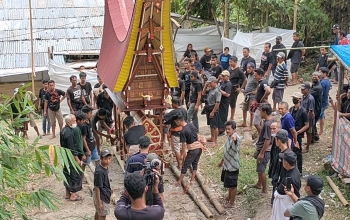
5 Days 5 Nights – Rambu Solo Toraja Cultural Tour
The Rambu Solo Toraja Cultural Tour (5 Days 5 Nights) offers a rare chance to witness one of Indonesia’s most extraordinary living traditions — the Rambu Solo, a sacred funeral ceremony of the Torajan people. This journey combines cultural immersion, local interaction, and breathtaking highland landscapes, giving travelers a deep appreciation for Toraja�... selengkapnya
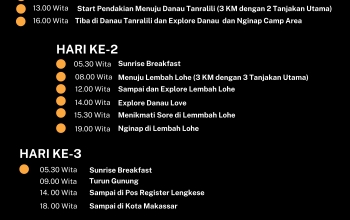
Itinerary Pendakian Lembah Lohe 3 Hari 2 Malam
Sulawesi Selatan bukan hanya tentang Makassar dengan Pantai Losari, kuliner khas seperti Coto Makassar, atau Benteng Rotterdam yang ikonik. Lebih dari itu, provinsi ini menyimpan sejuta pesona alam, terutama di kawasan pegunungan Kabupaten Gowa. Salah satu destinasi favorit para pendaki adalah Lembah Lohe, lembah hijau yang terletak di kaki Gunung Bawakaraen... selengkapnya
Kontak Kami
Apabila ada yang ditanyakan, silahkan hubungi kami melalui kontak di bawah ini.
-
Hotline
081316026384 -
Whatsapp
081316026384 -
Email
amiruddinemail@gmail.com

